Building a software/app of your own is a tedious task if not approached correctly. Besides finding the right development team, you must also identify the exact flow of building the application.
While the concept of breaking down the entire development process into stages is not new, you must have a proper understanding of what approach to choose and which will be the most fruitful for you.
Generally, the two most preferred approaches are Software Development Life cycle & Agile Development. Each of these approaches has its perks and drawbacks.
However, when it comes to choosing the one for your project, things can get confusing as the contrast between the two can be deceiving.
While one focuses on flexibility, the other focuses on a step-by-step approach. Over the years, both of them have proven to be effective, based on different factors.
So, which one to choose?
Well, that is the question that we are going to answer in this post. By the end of this one, you will be able to identify the differences, benefits, and drawbacks of choosing the SDLC or Agile Development approach.
We will also help you navigate through the factors that can help you choose the right development structure. So without further ado, let’s begin!
Why is Choosing the Right Approach Crucial?
A development model or methodology defines the course of action that a developer takes to complete a project.
The entire process of developing and building an application has several stages, each of which plays a significant role in the final product.
A development methodology helps you focus on all the minute details of the process.
It helps you identify all the basic and advanced requirements of the application, including –
- Plan the process to meet the timeline.
- Be aware of regulations and compliance.
- Keeping the entire process under budget.
- Create a workflow for ease of completion.
- Breaking down the process for effectiveness.
- Curating the right team to finish the project.
- Bringing together the perfect pool of tools & tech.
All in all, identifying the correct software development approach/methodology can be a game-changer for any project. However, you should keep in mind that while these approaches are often considered one-size-fits-all, they are not the same. For different circumstances and requirements, different methodologies can be used.
Software Development Life Cycle in a Nutshell
The software development life cycle, popularly known as SDLC, is a development methodology that takes every step into account and follows a sequence of steps.
The idea behind this approach is to be 100% sure of what you are building and act accordingly. This is considered to be the ideal approach for people looking for cost-effective and optimized development.
The SDLC provides a thorough framework for building software from scratch while focusing on the timeline suggested by the client.
That is because, unlike any other approach, there are stages in this one that have a pre-defined timeline for completion.
This means when the idea is discussed, you have a rough idea of how long it will take to complete the project.
► Stages of SDLC
Here is a breakdown of all the stages involved in the software development life cycle that will help you optimize your development process to the best of your ability.
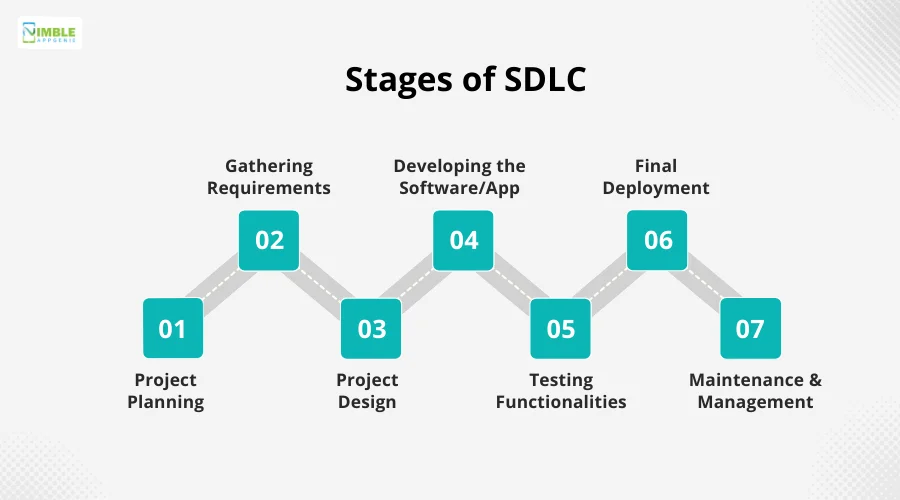
Stage 1 – Project Planning
This is the stage where the scope of the application is defined. Everything from how to build the application to how the final product will look. The objectives have been decided to begin the process.
Stage 2 – Gathering Requirements
Once the objectives have been decided, all the necessary resources are gathered. The requirements to reach those objectives are addressed, and every necessary resource is acquired.
Stage 3 – Project Design
Based on the requirements, the design of the application is as follows. The system architecture is crafted at this stage. The professionals ensure that the frameworks have all the necessary elements.
Stage 4 – Developing the Software/App
With a defined project design, it is time to define the development of the functionalities according to the design elements. This is the stage where the code is written to implement the decided features.
Stage 5 – Testing Functionalities
After every feature is integrated into the designed structure, the functionalities are tried and tested. This stage ensures that all the requirements of the client are met, functionalities are working properly and there are no bugs.
Stage 6 – Final Deployment
Planning the deployment refers to launching the final build and making it available to the public. The final build is extracted and then set for a launch in relevant environments and stores.
Stage 7 – Maintenance & Management
The job is not over after you have deployed the final software/app. Since the product you have built is now being used by regular users and that too in different environments, you must stay attentive to maintenance & management.
► Advantages of Using SDLC
The entire process of software development life cycle offers a series of advantages.
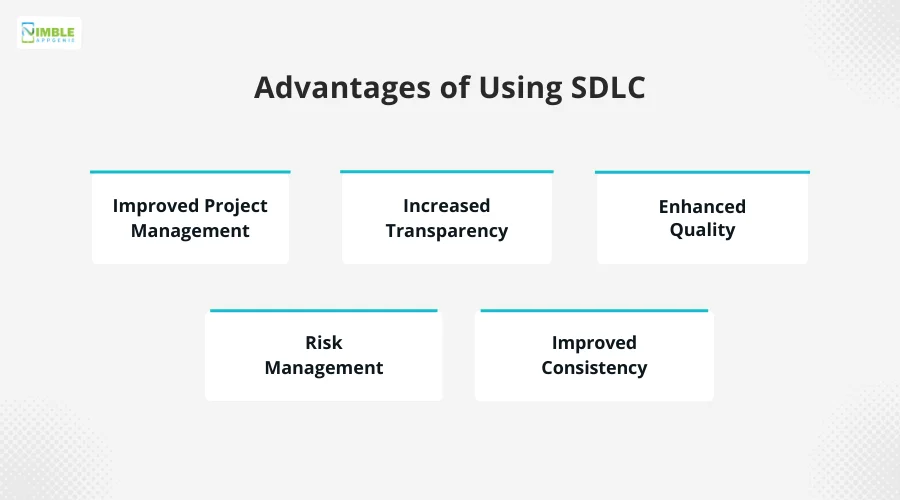
These advantages include –
- Improved Project Management: Since the approach uses a sequence of steps, the project can be easily managed as all you have to do is trace the stage, and you can identify the progress.
- Increased Transparency: Any client can simply understand what is the status of the development as the stages are defined clearly and the documentation is quite helpful for the client.
- Enhanced Quality: Since the stages have a defined objective to meet, teams work individually, improving the quality through easy issue detection and thorough testing.
- Risk Management: The approach offers easy-to-implement risk management tools that not only help boost the effectiveness of the project but also reduce the overall risk of project failure.
- Improved Consistency: The application when built through the SDLC approach is effectively more consistent which makes it more and more easy to manage and maintain.
► Disadvantages of Using SDLC
While the SDLC approach seems a simpler and more direct approach, it sure has its drawbacks that you must consider before opting for the same.
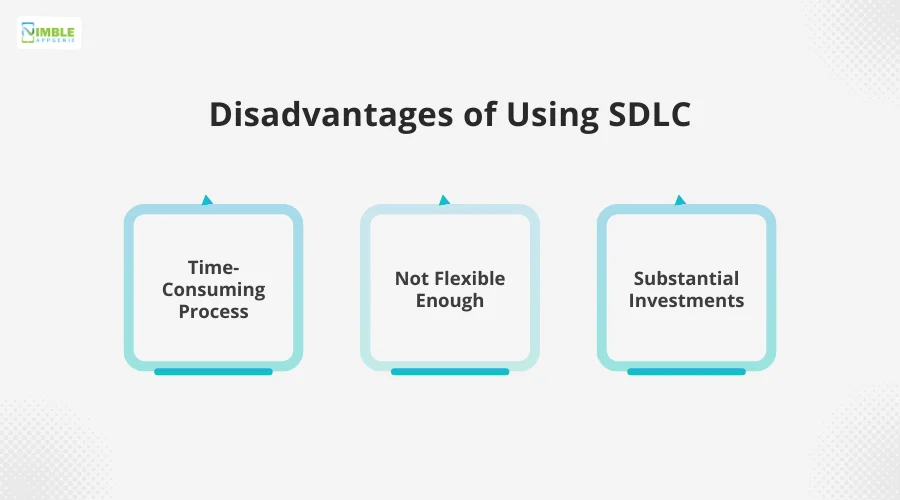
These disadvantages are –
- Time-Consuming Process: The SDLC is a time-consuming approach. Especially when you have a complex project. This often leads to delays in product delivery.
- Not Flexible Enough: The process is known to follow a sequential approach, which means if you plan to make changes to the software/app during the process, you have to implement them through all the stages, making it a difficult task.
- Substantial Investments: The upfront cost for starting an SDLC project is significantly higher than other available approaches, as it needs time, resources, and finances.
Agile Development Cycle: An Overview
While the SDLC approach is systematic, Agile Development takes a more flexible route. It is based on an iterative process that allows the developer to continuously work on the project in repeated increments until it finally works.
There is no particular sequence to follow, which makes making alterations simpler. This approach is popular among clients who are looking for flexibility.
The idea behind using the agile methodology is to break the entire development process into smaller and more manageable iterations that can be executed while taking care of the feedback that the client has shared.
The development cycle is divided into phases. These phases have individual sets of instructions that help in the thorough completion of the iteration to the satisfaction of the client.
The Agile Development approach is based on its values and principles. Let’s take a look at them to understand more about this cycle.
► Values of Agile Development
There are 4 values that the Agile Manifesto puts on the highest pedestal. These include –
- Individuals & Interactions Over Processes & Tools
- Working Software Over Comprehensive Documentation
- Customer Collaboration Over Contract Negotiation
- Responding to Change Over Following a Plan
The values clearly state that the agile development process is more practical and result-oriented, as the Agile estimation technique plays a pivotal role in it. Other than these values, there are 12 principles that it follows for the incremental development of the software.
► Principles of Agile Development
- Principle #1 – Our highest priority is to satisfy the customer through early and continuous delivery of valuable software.
- Principle #2 – Welcome changing requirements, even late in development. Agile processes harness change for the customer’s competitive advantage.
- Principle #3 – Deliver working software frequently, from a couple of weeks to a couple of months, with a preference for a shorter timescale.
- Principle #4 – Business people and developers must work together daily throughout the project.
- Principle #5 – Build projects around motivated individuals. Give them the environment and support they need, and trust them to get the job done.
- Principle #6 – The most efficient and effective method of conveying information to and within a development team is face-to-face conversation.
- Principle #7 – Working software is the primary measure of progress.
- Principle #8 – Agile processes promote sustainable development. The sponsors, developers, and users should be able to maintain a constant pace indefinitely.
- Principle #9 – Continuous attention to technical excellence and good design enhances agility.
- Principle #10 – Simplicity–the art of maximizing the amount of work not done–is essential.
- Principle #11 – The best architectures, requirements, and designs emerge from self-organizing teams.
- Principle #12 – At regular intervals, the team reflects on how to become more effective, and then tunes and adjusts its behavior accordingly.
Source: Agile Manifesto
All in all, the idea behind Agile Development is that it makes the entire process more client-oriented and makes it work continuously.
► Advantages of Using Agile Development
This approach offers some great benefits and advantages.
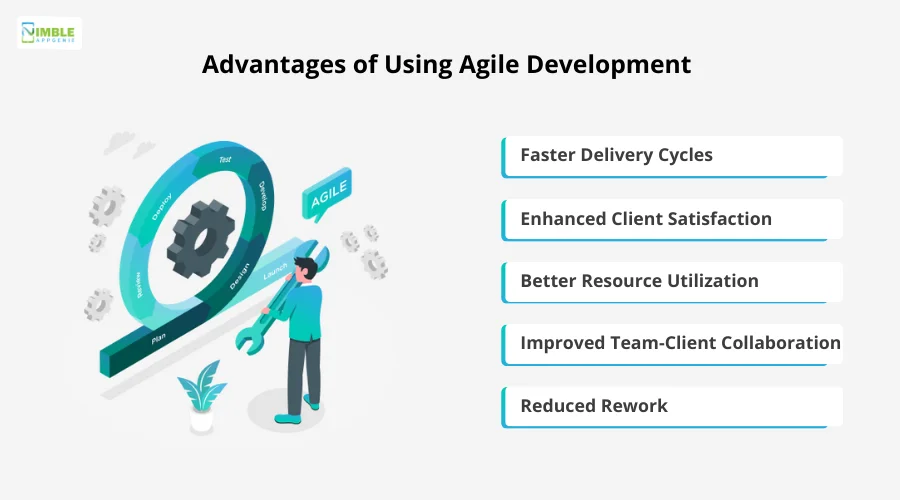
These advantages include –
- Faster Delivery Cycles: The development approach in Agile is significantly faster than SDLC as it offers a faster time to market.
- Enhanced Client Satisfaction: Since the client is directly involved at every step of the app development process, they are more satisfied.
- Better Resource Utilization: With all the teams working in sync with each other, the resources are used to their highest potential.
- Improved Team-Client Collaboration: Agile development as a concept allows team collaboration with the client, making it more and more effective.
- Reduced Rework: Generally, an app requires rework because of a process mistake. However, when you use Agile, the client is involved at every step, making it transparent.
► Disadvantages of Using Agile Development
Several benefits make the entire process appear highly viable for every app; however, just like a coin, the Agile Development approach also has two sides.
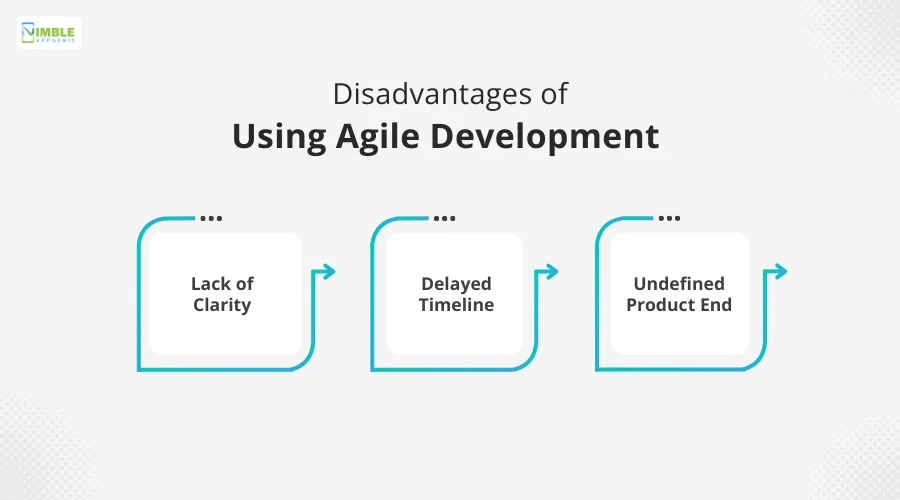
It also has its disadvantages. These are –
- Lack of Clarity: With multiple iterations, there is a high chance that your client and team will get confused while developing the application.
- Delayed Timeline: The ease of access allows a client to highlight changes in real time, however, this also means that the time taken to reach the final product can be delayed.
- Undefined Product End: Growing iterations can often introduce new proposals that defeat the purpose of staying on track.
Key Differentiating Factors Between SDLC vs Agile Development Cycle – Which One to Choose?
Learning about both approaches, you might have an idea of the difference between SDLC and Agile Development.
Looking at the core definition of the two, it seems that the only difference between them is in the way the processes work.
While one follows a sequence of steps for the entire project, the other one is more of a continued process that takes a multi-iteration approach to finish the process.
However, that is not all. There are several key differences between the two.
To understand these differences, let us first define the factors based on which these differences can be derived.
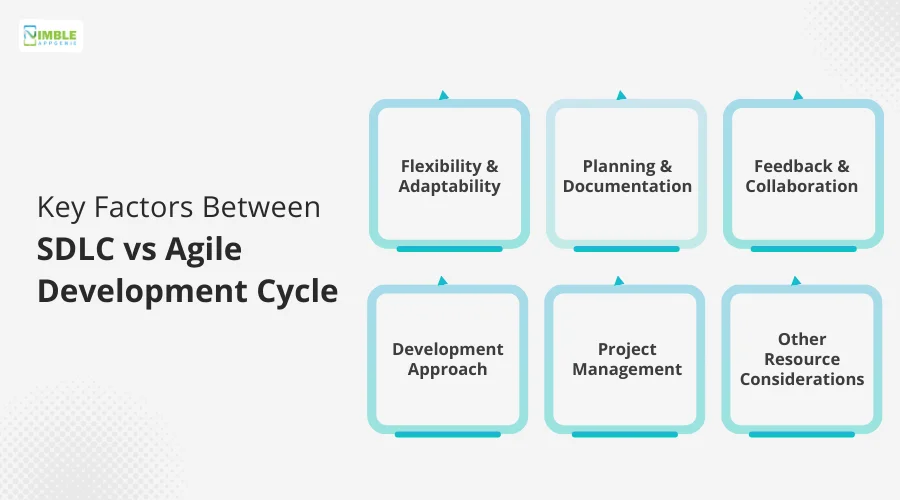
These factors are:
- Flexibility & Adaptability: How flexible and adaptable is the development approach?
- Planning & Documentation: What type of documentation and workflow is built into the approach?
- Feedback & Collaboration: What sort of feedback loop and client interaction does the approach offer?
- Development Approach: What is the exact approach of development that the project will follow?
- Project Management: What management style does the approach use to complete the task?
- Other Resource Considerations: How does the approach use available resources such as time & cost?
Based on these factors and considerations, here is a clear comparison table to help you clearly understand the differences between SDLC & Agile methodologies.
| Factor | SDLC | Agile Development |
| Flexibility & Adaptability | Less flexible when it comes to changes. | Highly manageable and easily receptive to changes. |
| Planning & Documentation | Focuses on detailed documentation at every stage of the approach. | Comparatively flexible on documentation and focuses more on hands-on planning. |
| Feedback & Collaboration | Tough to incorporate feedback as it takes a sequential route. Keeps the client away from the process. | Highly promotes collaboration and involves the client. All feedback can be easily incorporated thanks to an open approach. |
| Development Approach | SDLC uses a top-down approach that keeps formal documentation as a priority. | Agile Development uses a bottom-up approach, promoting collaboration & continuous changes. |
| Project Management | The SDLC approach uses more of a traditional management technique with defined documentation, roles, and responsibilities. | Agile development is more informal and works on adaptive planning and minimizes documentation, promoting collaboration & free flow. |
| Other Resources | SDLC is highly dependent on resources and time-bound. | Agile uses fewer resources and focuses on improving return on investment. |
Which Development Approach to Choose & Why? FINAL VERDICT!
Knowing the difference, you may be wondering what approach to choose. Ideally, you should let the development professionals help you take care of this question.
However, if you want to identify the differences between SDLC vs. Agile Development and choose the best, you should consider the following statements –
- Choose SDLC if you are planning to let the experts take over completely and want the final product before a certain timeline.
- Choose Agile Development if you are looking for a professional development process that keeps you completely involved, However, multiple iterations can cause delayed output.
Choosing SDLC can help you finish the project on time, while choosing Agile Development can provide you with flexibility and ease of change.
Either way, choosing the right approach is necessary to ensure that the app/software you plan to build is robust enough to hit the market.
Consider all the factors, advantages, and disadvantages, then find your fit.
How Does Nimble AppGenie Make the Decision Easier for You?
If you still find it difficult to choose the right mobile app development company approach, do not worry—you are in just the right place! We at Nimble AppGenie have decades of experience with hundreds of projects, which helps us identify the right approach for newer ones.
When you plan to build a new project of your own, you need to identify exactly what your objective is, when you want the final product to hit the market, how involved you want to be, etc.
That is where the team you choose plays a crucial role, as being from the industry, the experts can guide you to make the right decisions.
We at Nimble AppGenie take it one step at a time, breaking down the entire process.
Reach out to our experts and share your thoughts and requirements on how you want the application to work, and they will suggest the best approach for you.
Conclusion
Ideally, both SDLC and Agile development methodologies have their advantages and disadvantages. It is necessary to identify which one suits you and aligns with your vision.
This also means you can choose any of them based on your requirements. There are several use cases where each approach is highly helpful.
People usually get confused about choosing SDLC vs Agile development for a project, as they are not completely clear about which one is the most suitable. Hopefully, this post might have cleared it up for you!
With that said, we have reached the end of this post. Thanks for reading, good luck and remember to choose your development partner and approach wisely!
FAQs

Niketan Sharma is the CTO of Nimble AppGenie, a prominent website and mobile app development company in the USA that is delivering excellence with a commitment to boosting business growth & maximizing customer satisfaction. He is a highly motivated individual who helps SMEs and startups grow in this dynamic market with the latest technology and innovation.
Table of Contents






No Comments
Comments are closed.